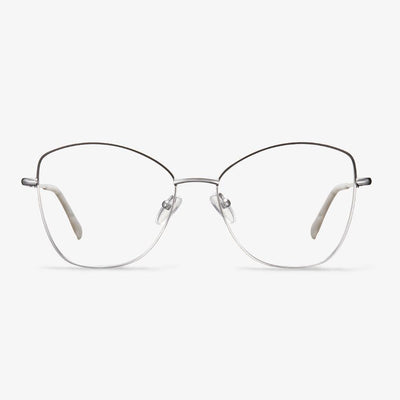Optometry glasses are not professional
Some people will not only experience dizziness when they change their glasses but also have headaches, nausea, vomiting, inattention, neurasthenia, and other symptoms from time to time. And some people even deepen myopia. This is most likely due to unqualified glasses and inaccurate optometry. In short, this eye discomfort is caused by the inconsistency between the power of the glasses and the actual condition of the eyes. Optometry before filling a prescription is a very important step. In addition to checking myopia and astigmatism, it is also necessary to check for eye disease, binocular vision balance, monocular ability, primary vision discrimination, interpupillary distance, etc. In this way, suitable glasses can be fitted according to the overall situation of the person's eyes. The spectacles must also match the parameters of vertex, interpupillary distance, cylindrical lens axis position, etc. Otherwise, it will directly affect the effect of correcting vision, cause the user's visual fatigue, and increase the emphasis on power loss.
Computer Protective Glasses
With the popularity of televisions and computers, electromagnetic radiation has become the No.1 killer of vision. The invention of radiation protection glasses is even more popular, and its market is also widely optimistic.
The lens design of the computer protective glasses has no side effects on vision. Refined with a high-tech vacuum ion coating, it can block 0% electromagnetic waves. The lens contains anti-radiation substances and has the function of absorbing positive charges. It can absorb low-frequency radiation microwaves and avoid potential eye fever, headache, fatigue, dryness, and other adverse symptoms caused by electromagnetic wave radiation. The penetration and absorption function of different light can resist radiation and glare, and the user will obviously feel clear and natural vision after wearing it. At present, there are mainly anti-blue lenses and anti-fatigue lenses, which can effectively prevent blue light radiation and relieve eye fatigue.
BLUPOND night driving glasses
TAC Semi-polarized Blue light goggles are designed to change your perspective to yellow with computer blue light polarization. Anti-glare high-definition vision blue-blocking glasses protect eyes from blue light and reduce the contrast of bright blue/white glare and flash. The anti-glare night glasses limit distortion. In addition to polarized driving glasses, you can receive a night vision glasses accessory set, with the EVA glasses hard case, screwdriver, sunglasses bag, microfiber cleaning cloth, glasses clip, and night driving glasses gift box.
QINA glasses
The clear frame glasses are classic, understated, simple, and stylish, defined by clean lines and minimal details. Whether you have an important meeting to attend or are relaxing in front of your favorite show, clear frames can easily blend into your wardrobe.
Founded in 2013, it is a fashion brand for young people and launched by the merger of two major eyewear companies Essilor and Luxottica. Dedicated to the study of pop culture and different product attributes, they bring interesting collocation creative inspiration for the young groups. Sunglasses and optical glasses are available, where stylish young people can find a variety of styles. Frame price is 300~500 or so commonly.
Frame Selection of Progressive Sunglasses
Choose a proper frame range. Only if the frame is not very large and beveled, the frame can be very flat. Because the distance from the glazed to the optical center of a progressive multi-focus lens is 19-17 mm, and the distance between the edges of the frame will be no less than 28 mm if the area inside the lens can be used at close range while maintaining the far sighting field.
1.67 vs 1.74 High Index Lenses: What Are Their Differences?
In this section, we will show you the differences between 1.67 high index lenses and 1.74 high indexes.
- 74 high index lenses are thinner and lighter than 1.67 high index lenses.
- 74 high index lenses are expensive than the 1.67 high index lenses.
- Both 1.67 and 1.74 high index lenses can reduce the eye distortion caused by strong prescriptions, 1.74 high index lenses perform better than the 1.67 high index lenses.
- As for the color of lens, both come in clear, gray-tinted and brown-tinted, but only 1.67 high index lenses come in Transition brown or gray.
- 74 high index lenses are better for those looking for the thinnest lens possible. So, patients with extremely strong prescriptions chooses this.
- 67 high index lenses are better for those looking to save money or those who do not have extremely high prescriptions. They are also the only choice if you are looking to get Transitions.
From the above information, you can find the main differences between these two lenses are price, thickness, weight, color options and general appearance. Most people who choose 1.67 high index lenses generally either do not have an extremely high prescription or are shopping on a budget. 1.74 high index lenses, on the other hand, are the thinnest and lightest plastic lenses currently in existence.
LeSplash glasses
The glasses are stylish and have a personality, and the shop decoration has a designer style. A combination of fashion and business, the nose pads are designed with water droplets that are more suited to Asian faces. Breaking the design idea of traditional glasses, the temple is under the glasses, and the arc of the temple makes the face look small. Breaking the bottom half of the frame, the top half of the frame is more designed, with comfortable, thinner lenses.











































